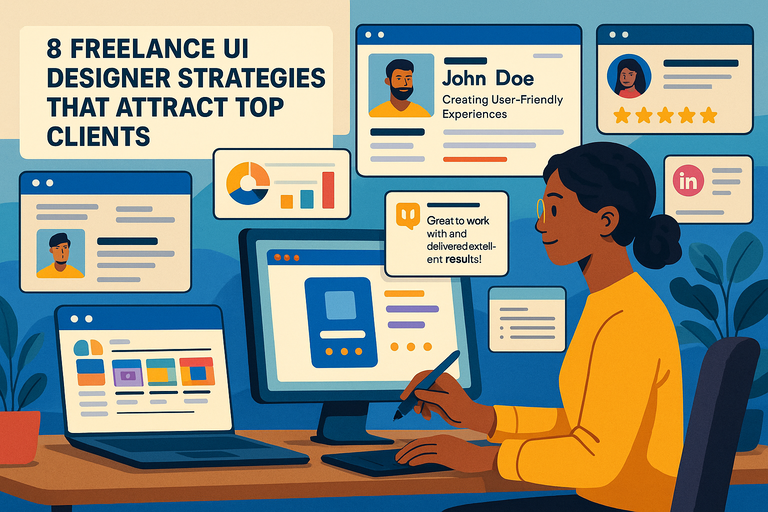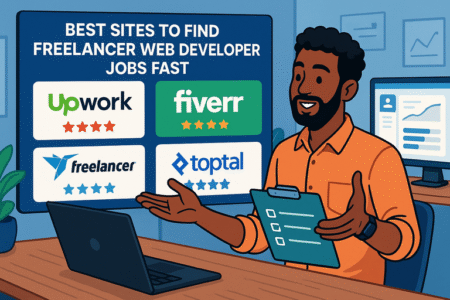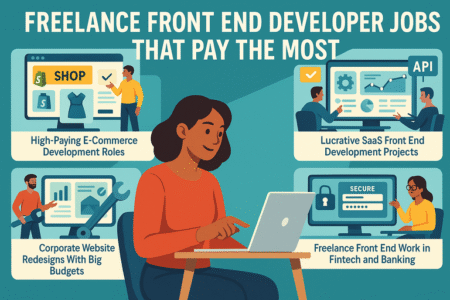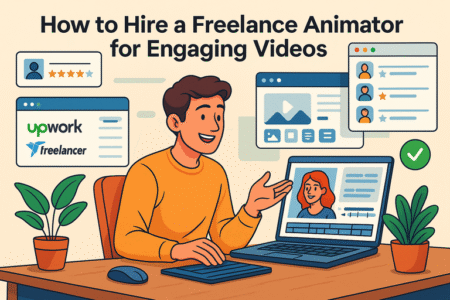Table of Contents
If you’re a freelance UI designer, you’ve probably wondered: how do some designers effortlessly attract high-paying clients while others struggle to find consistent work?
The truth is, thriving in the freelance design world isn’t just about having great visuals—it’s about building trust, visibility, and a brand that clients can’t resist.
In this guide, we’ll explore 8 powerful strategies that will help you stand out, attract top clients, and grow your freelance design business with confidence.
1. Build A Strong Personal Brand That Reflects Your Design Style
A strong personal brand helps you stand out in the crowded world of freelance UI design.
Think of your brand as a reflection of both your aesthetic and your professional integrity—it’s how clients recognize, remember, and trust you.
Define Your Unique Visual Identity
Your visual identity should instantly communicate your personality and design approach. It’s more than just a logo or color scheme—it’s the emotional impression your work leaves behind.
To get started, ask yourself: What kind of experiences do I love designing most? If you gravitate toward sleek, minimal dashboards, your branding should mirror that precision and simplicity.
On the other hand, if you design playful, user-friendly mobile apps, you might use brighter colors, rounded typography, and soft UI elements in your brand visuals.
Quick practical steps:
- Create a small UI style guide for your brand—colors, fonts, iconography, and grid spacing.
- Use this system consistently across your website, portfolio, and social media.
- Avoid using too many trends. Clients look for authenticity over aesthetic mimicry.
When your brand feels cohesive, clients can instantly tell whether your style fits their project—before you even make a pitch.
Craft A Memorable Designer Bio And Tagline
Your bio is often the first “conversation” clients have with you. It should sound human, approachable, and confident—not robotic or overly formal.
For example, instead of writing:
“I’m a freelance UI designer with 5 years of experience building user interfaces for web and mobile.”
Try something like:
“I design clean, intuitive interfaces that help startups turn complex ideas into experiences users actually love.”
Here’s what to keep in mind:
- Start with what you do best and who you help.
- Use a tagline that’s short, punchy, and emotion-driven.
- Show your human side—mention what motivates your design decisions.
This approach builds connection. Clients want to work with people who get their goals, not just those who can push pixels.
Showcase Your Values And Design Philosophy
Your design philosophy is what defines your creative DNA. It’s the “why” behind every layout, transition, and interaction you create.
To articulate it, think about these questions:
- What drives my design decisions—usability, beauty, emotion, or conversion?
- How do I define success in a project?
- What frustrates me about poor user experiences?
You might express your philosophy as a short statement on your website:
“I believe great design feels invisible—it removes friction and builds trust between people and products.”
When clients see your values clearly expressed, it signals maturity, intention, and leadership—all traits top clients look for in a freelance UI designer.
Align Your Online Presence With Your Niche
Your digital footprint should tell one consistent story. Every touchpoint—your portfolio, LinkedIn, Dribbble, and Behance—should visually and verbally reinforce your niche.
If your niche is fintech dashboards, show consistent examples of data visualizations, clean layouts, and interaction prototypes. For eCommerce, focus on checkout flows, product detail pages, and conversion-friendly designs.
Tips to stay consistent:
- Use the same avatar and banner images across platforms.
- Keep your usernames simple and uniform (like @alexcreates or @uiwithsam).
- Regularly update project descriptions to match the clients or industries you want to attract.
This alignment creates a professional ecosystem around your brand—one where clients can easily recognize your expertise and style.
2. Create A Portfolio That Sells Your Expertise
Your portfolio is more than a gallery—it’s your best salesperson.
It should guide clients through your creative process, show the value of your design decisions, and build confidence in your abilities.
Highlight Projects That Solve Real Client Problems
Clients care about results, not just visuals. They want to see that your designs solve real problems.
Instead of showcasing every project, focus on 5–6 that best represent your skills and results.
For each, briefly describe:
- The client’s challenge or business goal.
- Your design approach and reasoning.
- The outcome or measurable impact.
Example:
“I redesigned the onboarding flow for a SaaS platform, reducing user drop-off by 37% through simplified UI steps and micro-interactions.”
By showing the “before and after,” you demonstrate strategic thinking—a rare skill that separates you from average designers.
Include Case Studies That Show Process, Not Just Outcomes
Case studies turn your portfolio into a storybook of how you think. Don’t just show final screens—walk clients through your process.
Structure each case study like this:
- Challenge – What problem needed solving?
- Research – How did you understand the user’s needs?
- Design Approach – What were your key decisions?
- Results – What changed because of your design?
Even a short case study written in plain language is more persuasive than a static mockup. Clients love to see how you think, not just what you produce.
Design A Visually Cohesive Portfolio Layout
Your portfolio layout itself is a reflection of your design sensibility. Keep it clean, logical, and responsive across devices.
A few practical UI suggestions:
- Use clear navigation labels (e.g., “Work,” “About,” “Contact”).
- Show one project per screen scroll for focus and clarity.
- Include hover animations or interactive previews to give life to static screens.
If you’re using platforms like Webflow or Framer, leverage their component libraries to maintain consistent spacing, typography, and transitions. These small touches make your presentation feel polished and intentional.
Use Testimonials To Reinforce Trust And Results
Social proof is one of the most powerful conversion tools in a designer’s portfolio.
When clients leave positive feedback, it builds instant credibility. Add 2–4 short quotes that highlight your reliability, communication, and design impact.
Example:
“Working with Alex transformed our app’s usability. His insights helped increase our daily active users by 45%.”
To gather great testimonials:
- Ask clients right after a successful project handoff.
- Request feedback that focuses on measurable outcomes.
- Display them strategically on your homepage or below case studies.
Authentic testimonials don’t just sell your design—they sell you as a trusted creative partner.
3. Optimize Your Online Presence For Visibility
Your online presence is often the first impression clients have of you as a freelance UI designer.
A strong digital footprint makes you easier to find, easier to trust, and easier to hire. Think of it as your personal marketing engine—working for you 24/7, even while you’re designing.
Leverage SEO For Your Portfolio Website
Your portfolio is your digital storefront, and SEO (Search Engine Optimization) helps more clients find it organically.
Start by identifying keywords clients might search for, like freelance UI designer for SaaS apps or UI design for eCommerce. Once you’ve got your list, weave these naturally into key places:
- Your homepage title and meta description.
- Case study headings and image alt text.
- About page and service descriptions.
I suggest using a tool like Ahrefs or Ubersuggest to find long-tail keywords—phrases with less competition but clear intent.
Example: Instead of “UI designer,” optimize for “remote freelance UI designer for web apps.” It’s specific, searchable, and reflects real client needs.
Don’t forget technical SEO basics:
- Compress images for faster loading.
- Add internal links between projects.
- Submit your sitemap to Google Search Console.
These steps help search engines—and potential clients—discover your work effortlessly.
Use LinkedIn And Dribbble Strategically
LinkedIn isn’t just for corporate resumes—it’s a goldmine for freelancers. A well-optimized profile can attract inbound leads.
Here’s how to make it work:
- Update your headline to clearly state your service (e.g., “Freelance UI Designer Helping SaaS Startups Simplify User Flows”).
- Use your About section to tell your story and emphasize results, not just skills.
- Post once a week sharing lessons learned, mini case studies, or UI redesign insights.
Dribbble, on the other hand, is all about aesthetics and visibility. Consistent posting helps attract design-savvy founders and product managers.
I recommend adding short captions explaining why you made certain UI choices—this shows strategy behind the visuals.
For example: “Redesigned checkout flow reduced friction by minimizing form fields from 8 to 4.” That’s visual + value, which clients love.
Share Insights On Design Communities And Forums
Communities like Designer Hangout, Reddit’s r/UI_Design, and Indie Hackers are incredible for visibility and networking. But don’t just drop your portfolio link—add real value first.
I’ve seen designers gain long-term clients just by answering questions consistently. For instance, helping someone improve their onboarding UX can showcase your expertise publicly.
Quick tip:
- Share short design breakdowns (e.g., “3 UI fixes that improved user retention in my latest app redesign”).
- Include one small screenshot or GIF to catch attention.
- Link back to your full case study for context.
When people see your thoughtful contributions, they remember you as an authority—not just another designer promoting themselves.
Keep Your Social Profiles Consistent And Updated
Consistency builds recognition. Every platform you use—LinkedIn, Behance, Dribbble, even Instagram—should reflect the same tone, visuals, and messaging.
Simple consistency checklist:
- Same profile photo and color palette.
- Unified bio statement that describes your niche and expertise.
- Up-to-date links and contact information.
I advise reviewing your profiles every 3–4 months. Small tweaks, like updating a featured project or changing a banner image, show you’re active and relevant. Clients notice that.
4. Master Client Outreach With A Personalized Approach
Even with great visibility, you’ll often need to reach out directly to clients. The key? Personalization. Mass messages get ignored—but thoughtful, targeted communication opens doors.
Research Each Prospect Before Pitching
Before sending any message, take 5–10 minutes to learn about the client. Visit their website, explore their product, and note any UI weaknesses or opportunities.
For example, if a startup’s dashboard looks cluttered, you might mention:
“I noticed your analytics dashboard could benefit from more visual hierarchy—I’d love to share a layout approach that makes data interpretation easier.”
Use tools like LinkedIn Sales Navigator or Crunchbase to find the right decision-makers—often founders or product leads. Personalized outreach shows respect and effort, which immediately sets you apart.
Write Tailored Proposals That Speak To Client Goals
Your proposal should feel like a conversation, not a contract. Focus less on what you do and more on how it helps them.
Structure your proposal like this:
- Understand their problem: Summarize their challenge in one line.
- Show your approach: Explain how you’d solve it, referencing similar projects.
- Outline deliverables: Be clear about what they’ll get (e.g., “UI wireframes, prototype, final Figma components”).
- Close with confidence: Suggest a call to discuss their goals.
Avoid generic phrases like “I’d love to collaborate.” Instead, say something specific: “I believe simplifying your onboarding could boost user retention by 25%, based on similar work I did for a fintech client.”
That level of clarity sells.
Showcase Relevant Work Samples In Every Pitch
Attaching relevant samples makes your outreach instantly more credible. If you’re pitching a SaaS company, don’t send an eCommerce redesign—send dashboard or B2B app examples.
For best results:
- Create small project thumbnails (400x300px) showing before vs after screens.
- Use short captions that highlight measurable results.
- Host your case studies on your portfolio site and include direct links.
This helps clients visualize what working with you might look like, rather than leaving it to imagination.
Follow Up Professionally To Build Long-Term Connections
A polite follow-up can turn silence into opportunity. Wait about 5–7 days after your initial email, then send a short, friendly reminder.
Example:
“Hi [Name], I wanted to check if you had a chance to review my proposal. I’d love to share how a few UI changes could streamline your product flow. Let me know if next week works for a quick chat.”
If they don’t respond after two follow-ups, don’t push. Instead, keep them on your radar—comment on their posts, congratulate them on updates, and stay visible in a respectful way.
Clients remember professionals who are persistent, not pushy.
5. Position Yourself As An Expert In Your Niche
To attract high-value clients, you need to be seen as more than a designer—you need to be seen as an authority.
That means sharing what you know, where your audience spends time, and consistently giving value.
Publish Thought Leadership Content Regularly
Writing about design trends, UX insights, or case studies shows both expertise and credibility. Platforms like Medium, LinkedIn, and Substack are great for this.
A few content ideas:
- “How I Use Figma Components To Speed Up UI Delivery By 40%.”
- “3 Mistakes Startups Make When Designing Dashboards.”
- “How Good UI Design Improves Conversion Without Extra Features.”
I recommend posting once every 2–3 weeks. Include visuals—wireframes, flow diagrams, or before/after shots—to make your insights tangible. Over time, you’ll notice inbound inquiries from readers who connect with your perspective.
Speak At Webinars, Podcasts, Or Local Meetups
Even if public speaking sounds intimidating, it’s a powerful way to grow credibility. Start small—guest on a podcast or co-host a webinar with another designer.
These appearances humanize your brand and let clients “meet” you before hiring.
You might discuss practical topics like:
- How to streamline design handoff from Figma to developers.
- Why early user testing saves money in product development.
Recording short clips and repurposing them for LinkedIn or YouTube further amplifies your reach.
Offer Free Design Resources Or UI Templates
Offering free, useful content builds trust and visibility fast. You can share small things—like UI kits, component templates, or a “dashboard design checklist.”
Not only does this show your expertise, but it also introduces clients to your workflow and attention to detail.
Example: If you create a free “SaaS Onboarding Flow Template” in Figma, include a short tutorial on how to use it. When people download it, they remember you as the expert who made their job easier.
Collaborate With Other Creatives To Expand Reach
Partnerships multiply visibility. Team up with UX researchers, copywriters, or web developers to create shared projects or content.
For instance:
- Co-create a UX/UI redesign series on YouTube.
- Join a developer to produce a “UI + Code” mini guide.
- Participate in Dribbble challenges or Figma community templates.
These collaborations introduce you to new audiences who may need your services. Plus, it keeps your creative energy sharp and fresh—essential for long-term success as a freelance UI designer.
6. Use Networking To Build Authentic Client Relationships
Networking as a freelance UI designer isn’t about collecting contacts—it’s about creating meaningful connections that last.
Strong professional relationships can lead to steady client referrals, collaborations, and even friendships that make freelancing more sustainable and fulfilling.
Engage In Online Design Communities With Purpose
Online design spaces like Figma Community, Designer Hangout, Reddit’s r/UI_Design, and Slack groups such as Zeroheight DesignOps are goldmines for authentic networking—if you show up with the right mindset.
Don’t just drop your portfolio link and disappear. Instead, contribute value first. Share feedback on someone’s mockup, answer questions about prototyping, or explain a UI pattern you’ve used successfully.
When people see your thoughtful engagement, they remember you as helpful, not self-promotional.
I suggest setting a simple goal: spend 15 minutes a few times a week engaging meaningfully. Over time, you’ll become a familiar name—someone others tag when a client asks, “Do you know a good UI designer?”
Pro tip: Share small behind-the-scenes snippets, like “Here’s how I structure my Figma components for faster collaboration.” It’s specific, useful, and builds credibility organically.
Build Genuine Relationships, Not Just Transactions
The best client relationships often start with mutual respect, not negotiation. Approach networking with curiosity about people’s work and goals rather than viewing everyone as a potential lead.
Here’s what works well in practice:
- Ask about their challenges before offering help.
- Remember small details (like a product launch date or app update) and follow up on them.
- Keep the tone of your messages friendly but professional—think collaborator, not vendor.
For example, after completing a project, I often send a short message like: “I saw your product’s new feature launch—congratulations! It looks great.” It keeps the relationship alive without selling anything. Clients appreciate designers who genuinely care.
Attend Industry Events And Virtual Conferences
Even in a remote world, face-to-face (or screen-to-screen) interactions matter. Events like UXDX, Config by Figma, and Awwwards Live are excellent places to meet peers, founders, and design leads.
If travel isn’t possible, join virtual conferences or webinars. You can participate in Q&A sessions or comment thoughtfully in live chats—these micro-interactions can open doors.
I recommend preparing a short intro you’re comfortable with, something like:
“I’m a freelance UI designer who focuses on creating clean, conversion-driven web dashboards.” It’s concise, clear, and easy for others to remember.
Networking becomes less intimidating when you think of it as sharing enthusiasm for your craft rather than pitching your services.
Stay Top-Of-Mind With Past Clients Through Regular Updates
Your previous clients are your warmest network—people who already trust your skills. Staying visible to them can naturally lead to repeat work or referrals.
I suggest sending quarterly updates via email or LinkedIn messages.
Keep them short and genuine:
- Share one recent project or design insight.
- Mention any new tools or workflows you’ve adopted.
- End with a friendly note like, “Hope everything’s going well with your product launch this quarter!”
You can also post periodic updates on LinkedIn highlighting your design learnings or challenges. Past clients often see these posts and reconnect when new opportunities arise.
7. Set Premium Pricing That Reflects Your Value
Pricing as a freelance UI designer isn’t just about charging more—it’s about positioning your work as high-value and outcome-driven. Clients don’t pay for hours; they pay for transformation.
Understand Market Rates And Where You Fit
Start by researching the going rates for freelance UI designers in your niche. For example, designers on Upwork or Contra often list hourly rates between $50–$150 depending on expertise and region.
If you specialize in complex SaaS dashboards or design systems, your rate should reflect that depth. I recommend creating a rate range based on project complexity rather than a flat number.
Example pricing tiers might look like:
- Landing page redesign: $800–$1,200
- SaaS dashboard UI: $2,500–$4,000
- Full web app UI kit + design system: $5,000+
Knowing where you stand helps you quote confidently and avoid underselling your expertise.
Communicate The ROI Of Great UI Design
Clients understand costs, but not always value. Your job is to connect design decisions to business outcomes.
Use metrics when possible:
- “After redesigning a dashboard UI, my client saw a 30% increase in daily active users.”
- “Simplifying the checkout flow improved conversions by 25%.”
Framing your work this way positions you as a problem solver, not a visual decorator. When clients see the potential ROI (Return on Investment), your higher pricing feels justified.
You might say, “My UI approach helps reduce friction points, which can directly impact your retention rate and customer satisfaction.” It’s confident, informative, and client-focused.
Use Tiered Pricing Packages To Offer Choice
Tiered pricing helps clients feel in control and makes premium options look more valuable by comparison.
For instance, structure your offerings like this:
- Basic Package: 1-page UI design + handoff ($800)
- Standard Package: 3-page design + prototype in Figma + minor revisions ($1,500)
- Premium Package: Complete UI system + responsive variants + design handoff documentation ($3,000+)
This gives clients options that match their budget while subtly encouraging them toward the higher-value choice.
I suggest clearly explaining what each tier includes using bullet points—clarity reduces friction and confusion.
Learn To Confidently Say No To Low-Budget Offers
Saying no can be uncomfortable, especially early on—but it’s essential for growth. Taking underpaid projects drains time, energy, and creativity that could go into better opportunities.
I recommend keeping a simple, polite template ready:
“Thanks so much for reaching out. Unfortunately, I’m not able to take on projects at this budget level right now, but I’d be happy to recommend another designer.”
This preserves professionalism while setting boundaries. The truth is, clients who value quality won’t negotiate your worth—they’ll respect it.
8. Deliver A Client Experience That Encourages Referrals
Referrals are the heartbeat of a successful freelance career. When clients feel cared for and supported, they naturally tell others about you.
Every project is an opportunity to turn a happy client into a brand advocate.
Maintain Clear Communication And Timely Updates
Clients value transparency as much as talent. Set clear expectations from the start by outlining milestones, timelines, and feedback loops.
I usually suggest using tools like Notion or Trello to manage deliverables. It allows clients to see progress without needing constant check-ins.
You might update them weekly with:
- What’s completed
- What’s next
- Any questions or blockers
Clear, consistent updates reduce anxiety and make clients feel in control. That feeling of reliability is what leads to repeat business.
Use Smooth Onboarding And Offboarding Processes
The client journey begins before you open Figma. A seamless onboarding process builds confidence right away.
During onboarding:
- Send a clear welcome email outlining next steps.
- Share a simple questionnaire about goals and audience.
- Provide a timeline with checkpoints for feedback.
For offboarding:
- Deliver final files with organized folder structures.
- Offer a brief guide on how to use the assets.
- Thank them personally and ask for a testimonial.
A thoughtful process shows you care beyond design—it shows you’re invested in their success.
Gather Feedback To Improve Future Collaborations
Constructive feedback is your growth engine. I always ask clients two key questions at project end:
- What did you enjoy most about working together?
- What could have been smoother?
Their answers give you insight into both your strengths and potential refinements. Tools like Typeform make collecting feedback simple and quick. Over time, this iterative improvement makes your process feel more professional and dependable.
Encourage Testimonials And Word-Of-Mouth Referrals
The best marketing comes from satisfied clients. After a successful project, don’t be shy about requesting a testimonial. Frame it as helping future clients understand your process better.
Here’s a gentle way to ask:
“If you’re happy with the results, would you mind sharing a short testimonial about your experience? It really helps me build trust with new clients.”
Once received, display those quotes on your homepage or under specific projects. Authentic feedback acts as social proof—future clients feel reassured knowing others had a great experience.






